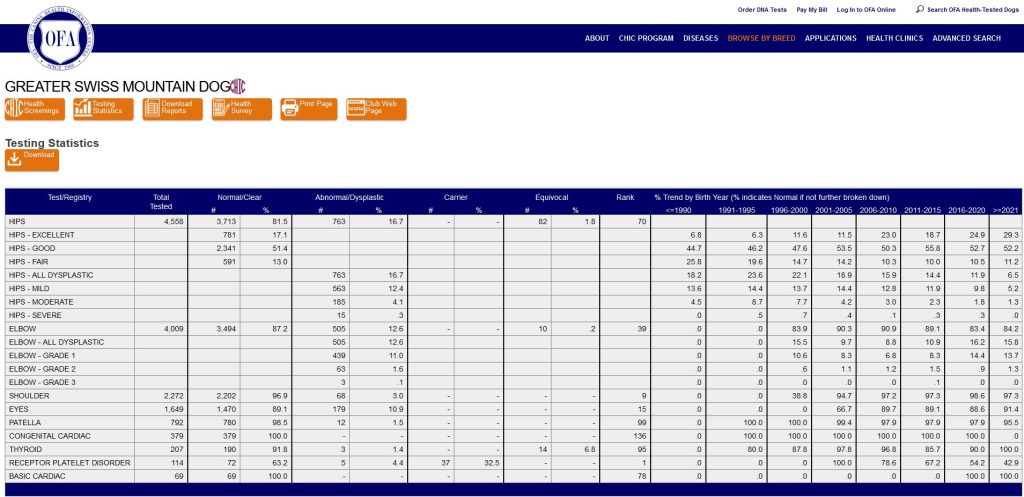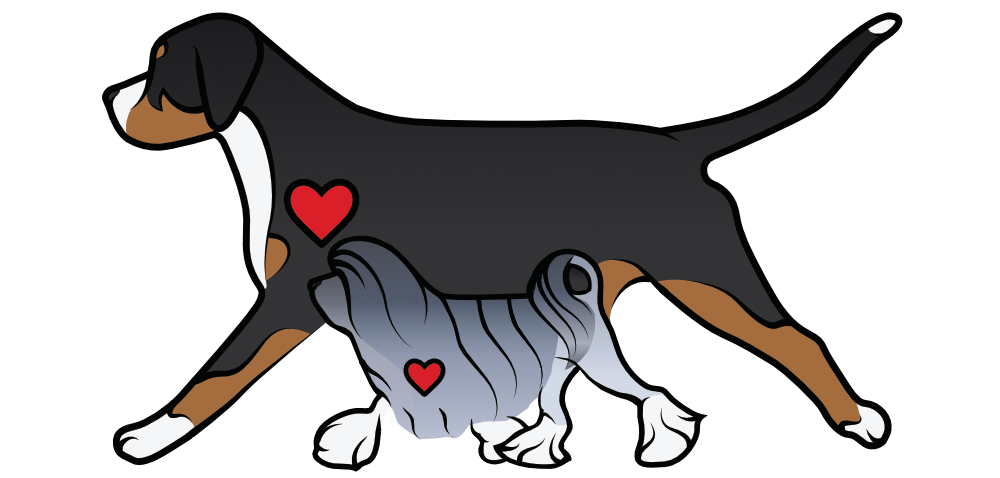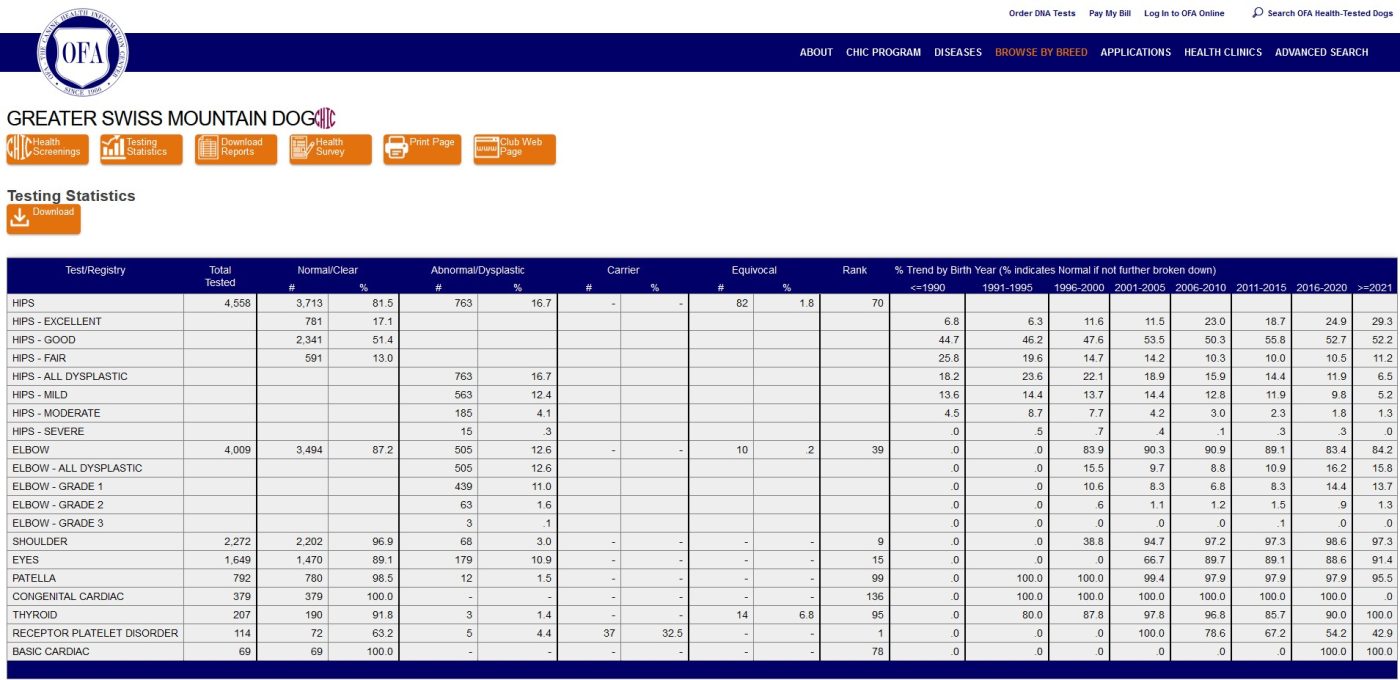Greater Swiss Mountain Dogs overall are a healthy breed. There are just a few health issues that are potentially life threatening, some require intervention, and a few others that require simple management. The Greater Swiss Mountain Dog Club of America is a great resource for health information. The OFA website also contains a self reported survey from Greater Swiss Mountain Dog owners that will help you understand the
The three tests recommended by Greater Swiss Mountain Dog Club are
- Eyes (every other year)
- Shoulders can be completed at 12 months old.
- Hip can be completed at 24 months old.
- Elbows can be completed at 24 months.
There are currently no genetic tests specific to Greater Swiss Mountain Dog that are indicative of health conditions. The empirical and scientifically validated research around the P2Y12 gene have not found any evidence that this gene is related to any health condition or unexplained bleeding. You can find the Greater Swiss health test results at OFA.org. Here’s a summary of the 2021 to present data along with some % from the self-reported survey (706 respondents).
- Eyes – 91.4% normal – rarely requires intervention
- Shoulders– 97.3% normal – may require intervention based on symptoms
- Hips – 93.5% normal – may require intervention based on symptoms
- Elbows – 84.2% normal – may require intervention based on symptoms
- Bloat – 3.1% from survey – requires urgent intervention, often surgical intervention
- Splenic Torsion – 0.9% from survey – requires urgent intervention, often surgical intervention
- Epilepsy – 5.6% from survey – requires daily medication and may require urgent intervention
- Unexplained bleeding/bleeding other – 0.7% from survey
In addition from ensuring that your puppy is from a breeder who has completed health testing on their Greater Swiss over generations and is transparent on health conditions that have no test, here are things you can do to reduce your risk or manage health issues.
- Eyes – rarely requires intervention
- Shoulders– limit strenuous exercise when young and maintain lean body condition.
- Hips -limit strenuous exercise when young and maintain lean body condition.
- Elbows – limit strenuous exercise when young and maintain lean body condition
- Bloat – limit strenuous exercise after eating and prophylactic gastropexy
- Splenic Torsion – prophylactic spleen removal
- Epilepsy – reduce exposure to toxins and unnecessary chemicals. Avoid use of Acepromazine during surgery and only use Heartgard and Frontline plus for heartworm, flea, and tick prevention.

What is the Orthopedic Foundation for Animals (OFA)?
OFA is a nonprofit organization that evaluates and certifies specific health screenings for dogs. It specializes in conditions like hip and elbow dysplasia, cardiac issues, and other inherited diseases. Owners can submit test results to OFA, which provides ratings and certification for individual dogs. You may hear the term “OFAed” or “Health tested” to mean that the dog has had results submitted to OFA. *Note: It can take some time for tests to be submitted and/or evaluated, and then posted on OFA.org.
What is the Canine Health Information Center (CHIC)?
The Canine Health Information Center (CHIC) is a database used in the United States that helps track relevant health information purebred dogs. It collects and shares health screening results, making it easier for breeders and owners to make informed decisions and reduce genetic health risks. *Note: Some health issues have a strong genetic component, and some do not. Some issues have a stronger environmental or epigenetic component than others.
How Are CHIC Health Tests Decided?
Each breed has specific health concerns, and they are not all equal in terms of impact to quality of life, if any. CHIC works with Breed Parent Clubs (also called National Clubs) to decide which tests are most important. These clubs use empirical research and expert advice from researchers to choose tests that address common genetic problems in the breed, if any. Once a dog completes the required tests and submits the results, it is assigned a CHIC number, showing it meets the breed club’s health testing recommendations.
What are Breeder Options noted on eye exams?
Breeder options noted on eye exams can be a complex topic. Many breeder options do not mean that the dogs have an eye issue or that the dog should never be used in a breeding program. Often, Breeder options on eye exams can be likened to a blemish. It is something to be noted, but requires no treatment and has no risk for future issues. For these options, the dog will often be noted as having a passing eye exam. These determinations are breed specific. It would not be appropriate to apply the same priority and decisions around eye health across different breeds. *Many of these breeder options will sound very concerning on Google, but in reality, they are not a concern.
What does DNA tested mean?
You might hear people say Embarked – Though this is a brand name, it has become a term to mean that dog’s DNA tested for the currently available genetic markers. There are multiple companies who offer canine DNA testing such as UCDavis, Paw Print Genetics, Wisdom Panel, and university labs. DNA Testing is not a replacement for health testing, though using DNA testing may be a way to complete some breed specific health tests. It is advised to study each breed carefully as 1. Some breeds do not have any health conditions that currently have any genetic markers. 2. Some breeds have identified DNA markers that do not mean anything. 3. DNA markers are not comprehensive tests for all known diseases. 4. DNA marker results are not indicative disease. Simply because a dog might be genetically affected, it may not ever actually have the disease.
What is *Embarked Clear?
Without context of the breed, this simply means that the dog was tested to not have the genetic markers it was tested for. Without understanding the breed and which tests were performed, this does not give buyers any actionable information nor is this a signal that the breeder is making breeding decisions based on health.

